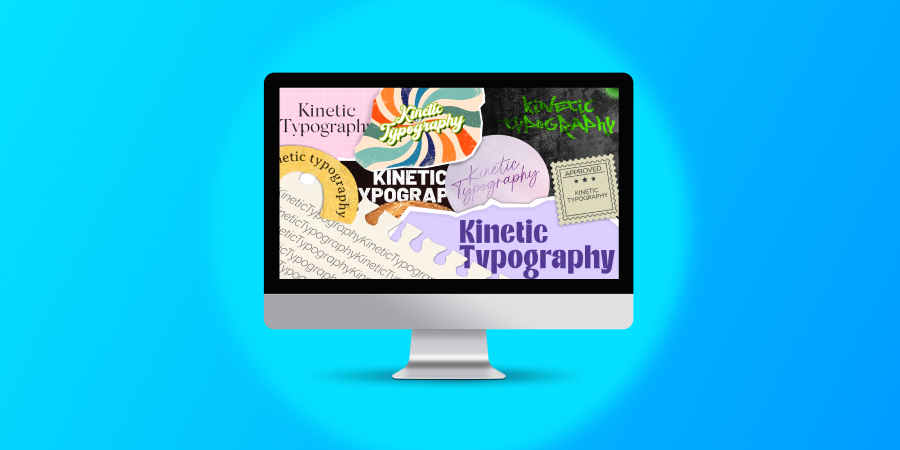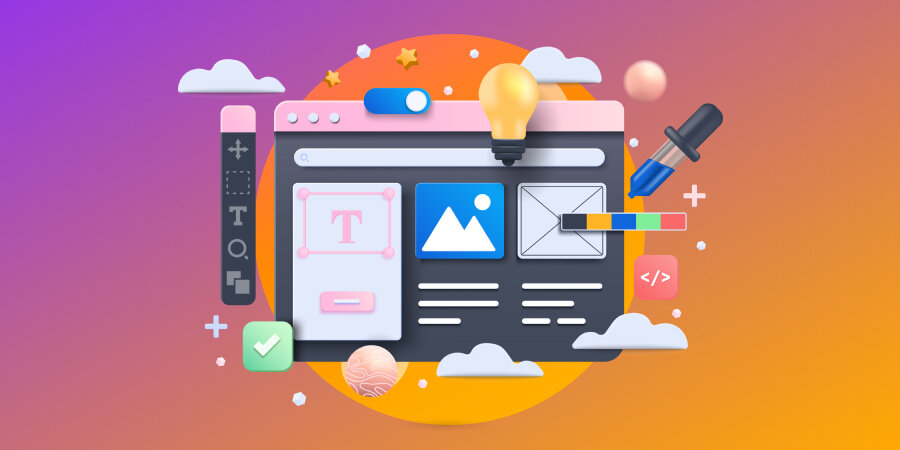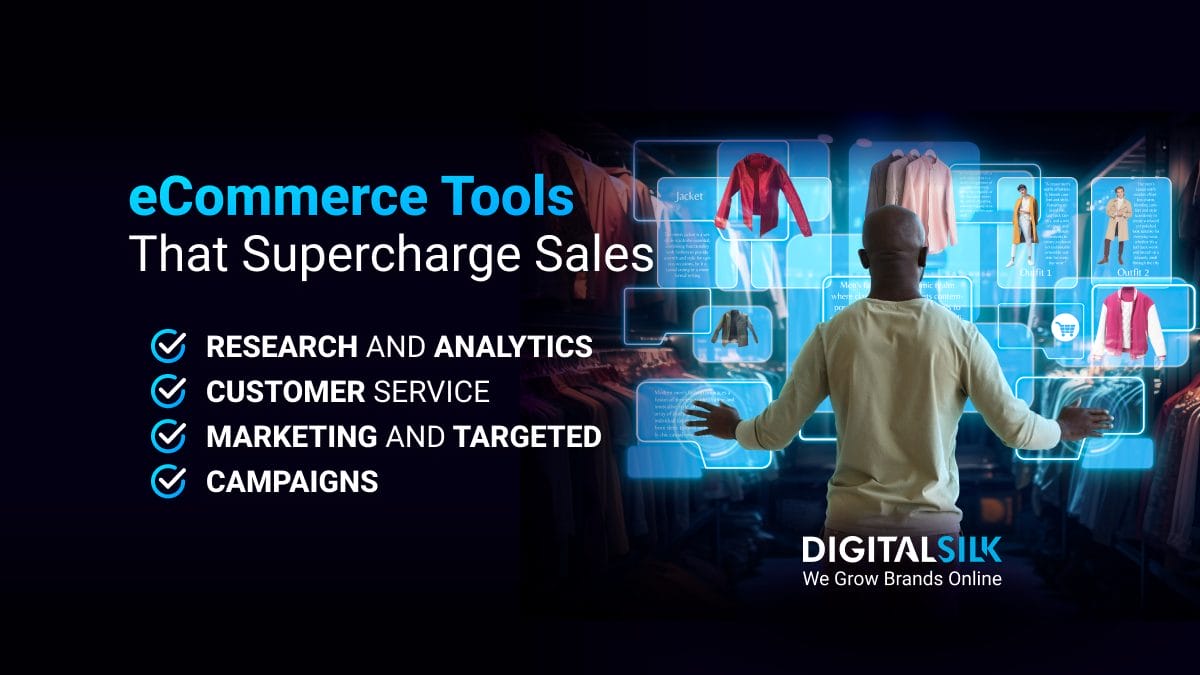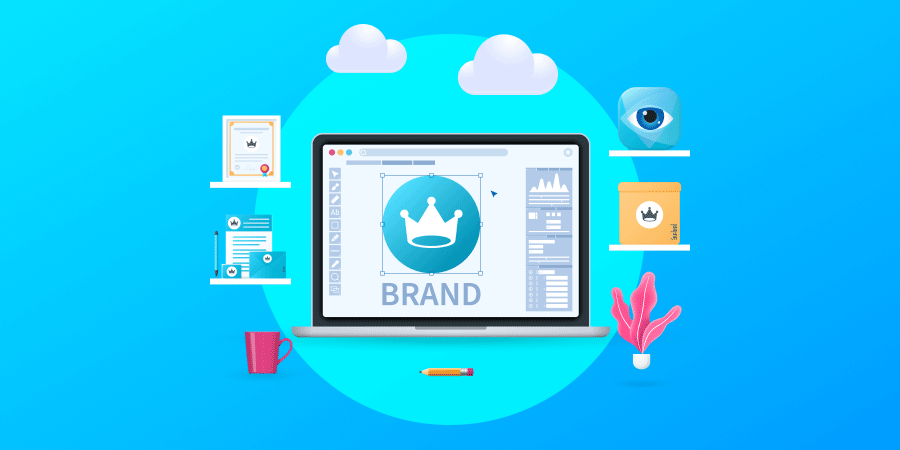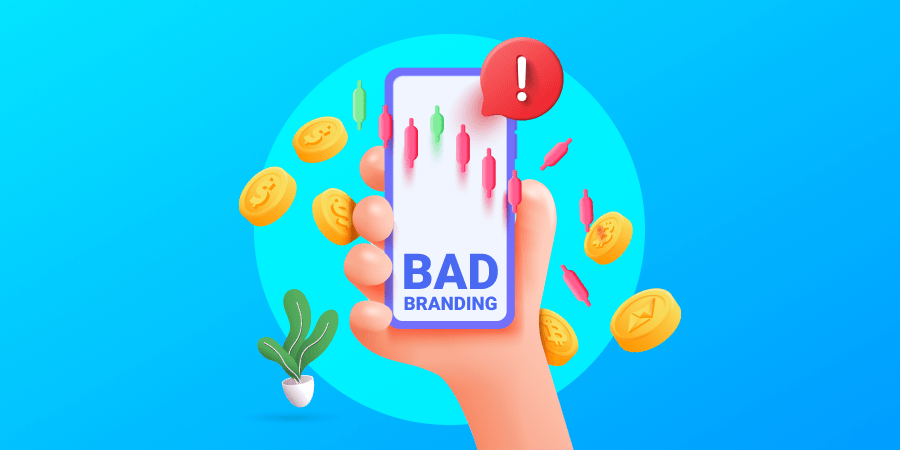What do marketers across all industries have in common?
Their number one goal is to find qualified leads and audiences.
One recent study suggests that as many as half of digital campaigns do not reach their target audience.
To help remedy this issue, Google launched a product called “custom intent audiences.” The program allows marketers to build audiences based on the most relevant keywords and online behavior. This makes ad campaigns more effective and less costly by serving the most relevant ads to the most qualified prospects.
In this article, we’ll look into Google’s custom intent audiences as a method of granular targeting and define how you can benefit from using it for your next campaign.
Work with our digital marketing experts. Request a quote
What Are Custom Intent Audiences?
Launched by Google in November 2017, custom intent audiences was created for more accurate targeting of users who are researching topics and solutions by visiting certain pages and using specific keywords.
With this tool, you can reach users based on their most recent purchase intent, as well as those who are looking for your specific products or services.
As explained by Google:
“Custom intent audiences help you define and reach the ideal audience for your business. Built with performance advertisers in mind, custom intent audiences allow you to go beyond pre–defined audience categories and reach people as they’re making a purchase decision.”
With custom intent audiences, you can reach your ideal users and target audience through display and video campaigns. You can also separate these audience groups into different segments, based on specific keywords and landing pages you wish to target.
Two types of custom intent audiences exist:
- Audiences generated automatically by Google’s machine learning algorithms
- Do-it-yourself audiences that marketers can create on their own by inputting keywords and pages related to their products
How Do Custom Intent Audiences Work?
Google’s custom intent audiences will help you find the audience that is most fitting for your campaign.
The program helps you reach users based on:
- Interest or behavior: Using interest keywords that represent your ideal customers as the main input, these ads target users who are most likely to have purchase intent for the said keywords. This is based on the content they search for and other behavioral signals.
- Websites they browse that are similar to yours: This type of targeting reaches your ideal customers who browse websites similar to the URLs you input.
- Apps they use that are similar to yours: The names of the apps your ideal customers are using or may use is the main input here. With this targeting, your ads are reaching people who use apps related to or similar to those you enter.
For example, a brand that sells high-end men’s apparel, like Paul Stuart, can narrow down its audience by entering interest keywords such as “modern classics,” “luxury tailored clothing” or “gentleman lifestyle.”
The brand could also use the URLs of websites with content on the high fashion history, luxurious destinations, fashion, culture and arts.
When adding apps, this brand would likely tap into the Lifestyle category and look for the most popular and best-rated apps there.
What Audience Options Do Custom Intent Audiences Have?
With custom intent audiences, Google has streamlined its Display, Gmail, YouTube and Discovery campaign types and placed them under the same umbrella.
Custom intent and custom affinity audiences that you may have previously known as a marketer are now called custom audiences. You can:
- Use audiences you created previously: When creating an audience for any type of campaign, you may opt for an audience that you created previously using the old custom intent or custom affinity interface. The Audience pane’s “Browse” section will show these existing audience options. Hovering over each will display what keywords they consist of.
- Create new custom audiences: If you choose to create a new custom audience from scratch, you can input interest keywords that will, as we’ve pointed out before, inform Google who your ads should target. You may also add specific search terms that will align with users who search for those or related terms.
- Target audiences beyond keywords: Finally, you may want to opt for other targeting methods that include people who visit certain types of websites or use certain types of apps. Google will populate the estimated audience size as you add options to any section. Google’s system will interpret signals such as campaign goals, keywords and bidding strategy to choose the target audience focused on consideration, performance and reach. These options help Google narrow down a specific audience, as it treats inputs as a list of criteria to choose from.
How To Create Custom Intent Audiences
When creating custom intent audiences, you should consider these five search parameters:
- In-market keywords
- Main competitors
- Search volume
- Competitors’ keywords
- Competitors’ pages
To create your business’ custom intent audiences and make the most of this feature, follow this step-by-step process:
- First, you need to sign in to your Google Ads account.
- After clicking on “Display Campaigns” from the navigation panel, select one of the active campaigns or create the new one and click “Audiences.”
- In the “Audiences” tab, select an ad group, followed by “Narrow targeting” under “Targeting.”
- Then, click the plus icon next to Audiences.
- Next to “Targeted audiences,” click the pencil icon and under the “Browse” tab, select “What they are actively researching or planning (in-market and custom intent).”
- Next to “New custom intent audience,” click the blue plus icon and create the name for your custom intent audience.
This is also where you should add keywords that this audience is researching and those that are related to your products or services. - Finally, under “Audience size,” you can check out the potential reach of your campaign, info about your targeted demographic and metrics such as conversion rates.
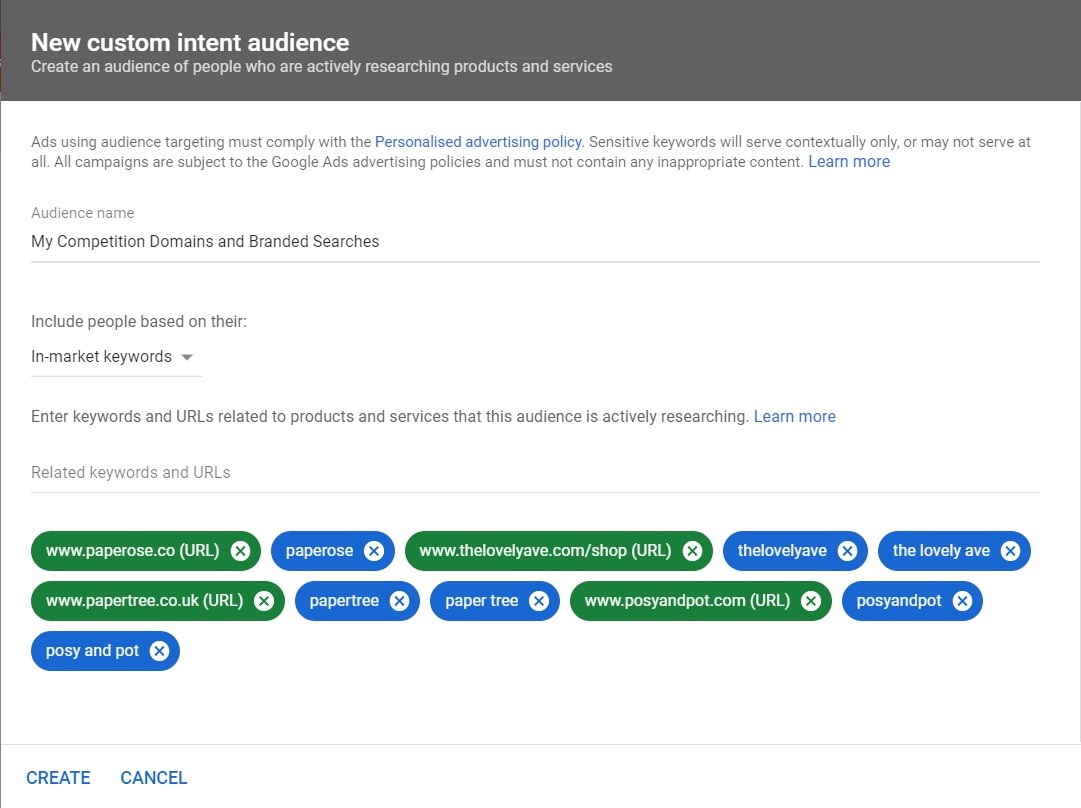
When you decide on your keywords and URLs to use, be sure to consider the keywords and websites your prospective customers are using to find related content.
If you use auto-generated audiences by Google, you can find out the key traits of your audience by hovering over the audience name. The info there will tell you:
- What the associated keywords from your account are
- What common keywords and URLs related to your products the audience is using
- What Google’s predefined audience is based on
By allowing you to go outside the predefined audience categories, custom intent audiences allows you to introduce new prospects to your business.
These prospects should be interested in what you have to offer and it should go without saying that when there is a higher chance of conversion, a higher ROI on paid searches becomes a reality.
Other reasons why your business should jump aboard custom intent audiences include:
- You can market to your competitors’ buyers
- Your brand can become a thought leader in a certain topic
- Custom intent audience targeting cuts down costs of less accurate ad campaigning
What Are The Benefits Of Custom Intent Audiences?
This step-by-step marketing strategy can be applied immediately. It reduces waste in ad budgets and eliminates the stream of irrelevant online ad experiences by targeting very specific, high-quality prospects.
Besides maximizing your budget and reaching ideal customers who are interested in your offering, custom intent audiences also allow your business to:
1. Tap Into Competitors’ Targeting Data And Advertise To Their Customers
Custom intent audiences allow you to perform competitive research to gain insights into the keywords that drive traffic to your competitors’ most visited pages.
The data you collect this way can be used for custom intent audience campaigns and marketing to your competitors’ website visitors.
For example, a company offering online marketing services could look into the most popular services offered by a reputable digital marketing agency and create a custom intent audience of businesses that are purchasing these services, to use for targeting.
2. Become A Thought Leader On A Given Topic
The right use of custom intent audiences can make your business a thought leader in your specific industry.
Even with the best search engine optimization practices, most websites need to wait for months, or even longer, in order to rank on the first page of search results.
Responsive digital display ads that use custom intent audiences can reach the same result much faster and with a higher ROI!
By using the URLs of the websites that are on the first page of Google, your business can reach the same users in a very cost-effective way through custom intent display campaigns.
This will send the same users to your article and build a retargeting list to use later in other marketing channels.
3. Cut Down Targeting Expenses
While search ads usually come with a high cost-per-click, custom intent audience campaigns are significantly cheaper, even though they also target high-quality prospects.
Specifically, responsive display ads featured in custom intent audience campaigns get more clicks, impressions and a higher click through rate at a lower cost compared to static ads.
4. Reduce Ad Spend Waste
Custom intent audiences also reduce ad budget spending by giving you the opportunity to target only the most likely customers using relevant offers.
The custom intent audience ads are only shown to specific groups of people who are interested in a specific topic related to your products or services.
This means there are fewer wasted impressions, which typically happen when businesses target very unspecific categories or have too wide of a target audience.
Custom Intent Optimization: Additional Benefits
Besides optimizing your ad campaigns with custom intent audiences, you should also think about optimizing your respective channels and landing pages for your audience’s search intent.
The quality of custom intent optimization will determine how qualified and relevant your traffic will be.
Better search intent optimization means improved conversion rates for transactional landing pages. Other pages, especially those catering to informational intent searches, will benefit from this, with:
- More page views: A user whose intent you have met is likely to keep browsing and engaging with your website.
- Reduced bounce rates: When a user finds what they looked for, they tend to stay on the page.
- Reach of a more relevant audience: By analyzing search intent and aligning your content and pages according to it, you can attract a valuable audience who is interested in what you offer and, therefore, of higher relevance to your business.
These perks can lead to more qualified traffic and leads for your business and much bigger engagement with your website.

Optimizing Campaigns & Content For Custom Intent Audiences: Bonus Tips
Even before you launch an ad campaign, you should align the rest of your content with the upcoming campaign. This will ensure that when you reach your target audience, they’ll see consistency between the promise of the ads and your content.
This is critical for forming a trusting relationship with your audience who will expect to find exactly what your custom intent audience campaigns have promised them.
1. Look At Search Results & Top-Ranking Pages For Search Intent Clues
The most effective way to optimize your content for custom search intent audiences is to analyze and learn from the top-ranking pages and SERPs.
This analysis helps with understanding what users are looking for. It also informs your content and tells you what topics you should cover.
Analyze the “People also ask” section: This Google search results section shows questions that users frequently ask and that you can provide answers to in your content.
These questions are a direct insight into what users are interested in and even how they formulate their questions. This is especially useful for informational intent queries.
Visit the pages that rank best: Getting to know the pages that users most frequently visit is the best way to understand their search intent and determine what kind of content they want.
2. Check The Ranking History Of Target Keywords
When you research keywords for the topic users search for, you need to consider the ranking history of the keyword, not just the present ranking.
This is because relying solely on the current ranking is judging it on a small timeframe. This keyword ranking may change and fluctuate in the future.
You need to know how it behaved in the past to know how it will behave in the future. Frequent changes could alter your perception of the keyword’s worth for user search intent.
You can check the ranking history of a target keyword using tools like Ahrefs Keyword Explorer and determine whether:
- There are no ranking fluctuations: This shows that top-ranking keywords and pages have always been ranking good and that they are a good indicator of continuous search intent.
- There are fluctuations of some pages: Some of the top-ranking pages are a good indicator of search intent. The keywords they contain could be good to target, but your content has to align with the main intent behind them.
- There are a lot of ranking fluctuations: This indicates that the search intent for these pages and keywords is always changing or that Google cannot fully understand the search intent. Avoid targeting these keywords because search intent for them is not clear.
3. Align Your Content Type, Format & Angle With The Best-Performing Content
Once you’ve located a keyword with a clear search intent, you should analyze the search results for:
- Content type: The kind of content in the search results that performs the best, which may be:
- Blog posts
- Landing pages
- Product pages
- Category pages
Interested in how blogs contribute to your SEO performance? Check out the video below by our Head of Content at Digital Silk, Emma Debeljak:
Look for the most prominent type of content in the search results and align your own content with it. If blog posts are the most frequent type of content, then create blog posts; if it’s landing pages, go for a landing page.
- Content format: The layout of the top-ranking pages, such as:
- List posts
- Tutorials
- How-to guides
- Reviews
- Comparisons
Similar to the content type suggestion, follow the successful crowd when it comes to creating content. Identify the content format that constitutes the majority of results and align your content’s format with that.
- Content angle: The unique approach to the article and its selling point. It provides insight into what users value when making this particular search. Again, align your own content with the most frequent content angle because that indicates what your audience is most likely to gravitate toward.
Custom Intent Audiences Takeaways
Google’s custom intent audiences tool is the most efficient way of targeting users based on their intent to help lead them to relevant products and services that you can provide.
When creating custom intent audiences, it is important to know that:
- Using custom intent audiences, you can:
- Market your services to your competitors’ buyers
- Make your brand a thought leader
- Reduce advertising costs
- To master the optimization for search intent, you should:
- Look at and learn from the top search results
- Check the ranking history of target keywords and popular pages
- Align your content’s type, format and angle with the best-performing pages
- Custom intent optimization’s main benefits are:
- Higher conversion rates and increased ROI
- Becoming a thought leader on a given topic
- More page views
- Reduced advertising expenses and ad waste
- Reduced bounce rates
- Attracting a relevant audience
"*" indicates required fields




